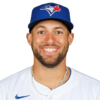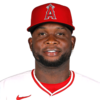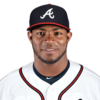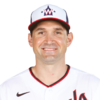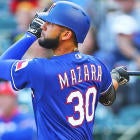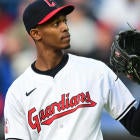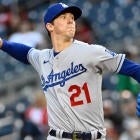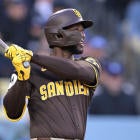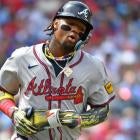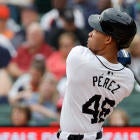Some hot starts are easily dismissed as just a few good games, destined to be lost in the sea of a long season. However, when they come from young players, or guys we’ve seen be great before who are trying to get to that level again, it’s worth stopping and taking notice.
We’ve only got one week of games behind us, but it’s still fun to wonder what a hot start might mean moving forward. So we’ll do just that, dreaming on eight of the league’s best hitters through the first week -- and then throwing a bit of cold water on what they’ve managed to do so far.
What if … everything just clicked for Nomar Mazara. There’s no doubting Mazara’s talent and pedigree are rare, and sometimes it just clicks. This was one of the top hitting prospects in all of baseball a year ago, who held his own in the majors, hitting 20 homers with a .266 average in 145 games. The natural power is evident, and he actually struck out at a below-average rate as a 21-year-old, a good sign moving forward. With how hard he hits the ball from the left side of the plate, Mazara has Freddie Freeman-like upside, while playing in a park and lineup that exaggerate his already prodigious skills. Mazara has top-10 outfielder upside, and he’s well on his way to his first 100-RBI season, with nine in the first six games.
More realistically … Mazara is off to a hot start, and proved last season he can put a charge into a ball -- note his fifth-highest average homer distance last season. However, consistency was a constant issue, as his 28.7 percent hard-hit average indicates. There’s no doubt Mazara has upside, but it’s going to take a lot more than a week to know whether he’s ironed out those consistency issues.
What if … last year in Triple-A was real? Mitch Haniger was a popular breakout candidate, and his 1.098 OPS in his first taste of Triple-A was a big part of it. Haniger is another player who has embraced the fly-ball revolution, having rebuilt his swing to prioritize flyballs and tap into his power, and that’s what we’re seeing right now. 10 of his first 18 batted balls so far have been hit into the air, consistent with the approach he has talked about. We’ve seen a similar approach turn unheralded players like Josh Donaldson and A.J. Pollock into stars, and Haniger could be the latest. He rode that approach to a 30-homer pace in 2016 across all levels, and he’s got a nice head start.
More realistically … Haniger’s Triple-A performance was a major outlier, and the gains he made didn’t really take hold until he got there. Was it a real change, or just a hot half-season? As nearly 1,500 plate appearances elsewhere in the minors indicate, the latter is more likely. Haniger can be useful, but I’m not buying a star turn.
What if … J.T. Realmuto is tapping into more power? Realmuto has always had a pretty rare skill set for a catcher, with his athleticism standing out at the position. That athleticism gives him an edge in speed, and helps sustain a higher batting average with some ground-ball hits most catchers can’t manage. However, his power seemed pretty established after he followed up a 10-homer rookie season with 11 in 2016, and there hasn’t been much expectation for more. However, with two homers in the first week -- and a double and triple for good measure -- Realmuto may be tapping into something more. A .290 hitting catcher who steals 10-plus bases goes from “nice” to “borderline elite” if he can jump from 10-12 homers to 15-plus. Especially with the Marlins batting him first or second in the order so far.
More realistically … Realmuto is pretty close to a finished product at this point. He wasn’t considered a player with a ton of projection throughout the minors, and with an average exit velocity 2 MPH below league average to date, it’s not like he really looks like a brand new player.
What if … The guy we expected in the minors is finally here? Thirty-two homers per-162 games in the majors is nothing to scoff at, but we were promised more with George Springer. This was supposed to be the kind of young player who could flirt with 40 homers, as he did in his massive 2012 season between Double-A and Triple-A. In the first week, Springer has been putting the ball in the air more, and pulling it more when he does so, a great combination with the Crawford boxes out there in left field in Houston. He played at a 40-homer pace after getting called up in 2014, so we know he’s capable of it.
More realistically … Springer has just had a bit of good luck. One of his homers traveled just 353 feet, according to HitTrackerOnline.com, and another went just 378 feet. There’s a pretty good chance neither would have been out if he had hit them in a different park. Are we really talking about Springer as a different player if those had been two relatively long outs?
What if … MIguel Sano is ironing out the flaws in his game? Sano is always going to bring whiffs and strikeouts to the table, but, in the best-case scenario, he learns to manage them, the way the likes of Giancarlo Stanton and Chris Davis do at their best. So far, that’s what we’re seeing, as Sano has cut his whiff rate down to 12.4 percent from 14.0 percent last year. It’s only 100 pitches, but that’s exactly the kind of change we needed to see, and if it can lead to a strikeout rate more in the 30 percent range -- rather than 36 percent he was at last season -- Sano can still absolutely be a star. There aren’t many players with 50-homer upside, and Sano just needs to make a few tweaks to his game to have a chance. We’re seeing them now.
More realistically ... This is just a small-sample size fluke. With just 101 pitches faced on the season, Sano is an extra swing-and-miss or two away from being right where he was last season. Sano has been more aggressive, swinging at 50.5 percent of pitches he’s seen, and it’s hard to imagine that change in approach leading to fewer swings and misses for someone with so many holes in his swing.
What if … Last year was real? We didn’t really take it seriously, because Nicholas Castellanos’ track record just didn’t support his breakout in an injury-shortened 2016 season. However, Castellanos was on a near-30-homer pace, clubbing 18 in 110 games, and his flyball rate continued to increase, along with his hard-hit rate. It’s hard to stand out at third base, and Castellanos never really had before. However, he showed he could last season, and has been absolutely crushing the ball in the early going, sporting a 95.2 MPH average exit velocity, nearly 7 MPH more than the league average. Castellanos is still young enough, having just turned 25, to really be breaking out, and he’s starting to look like teammate J.D. Martinez in a lot of ways.
More realistically … Castellanos is just a run-of-the-mill third baseman. Even last season, Castellanos we hardly a top-12 option at the position, with middling run production numbers even with the power breakout. There are just too many good third basemen to get excited about him.
What if … Yasiel Puig is back? Unlike the first four players on this list, we don’t have to imagine what a superstar version of Puig looks like. We saw it in his first two major-league seasons when his preternatural bat-on-ball abilities overcame any rawness in his approach. However, injuries slowed him in recent years, and exposed those rough edges, leading many Fantasy players to give up on him. What if Puig is just healthy? That might be all it takes for him to get back to his 2014-15 levels of production. And, of course, a more flyball-oriented approach at the plate wouldn’t hurt either, if he could manage it.
More realistically … The best predictor of future injury is past injury. Puig may be healthy now, but after missing 141 games over the last two seasons, one week without a hamstring pull isn’t exactly rock-solid proof of anything. The question with Puig isn’t ability, it’s health, and if you’re still worried, this week doesn’t change anything.
What if … Ryan Zimmerman keeps hitting the ball in the air? Zimmerman struggled through his worst season in years, but was still generating plenty of bat speed and hitting the ball hard, but he was just hitting the ball hard into the ground too often and wasting all that bat speed. As with Haniger and Puig, he has talked about changing his swing to generate more power, and the early results are promising. Even beyond the three early homers, Zimmerman is hitting fewer groundballs so far. If he can keep that up, Zimmerman’s chances of breaking out are real.
More realistically … It’s too hard to teach an old dog new tricks and, at 32, Zimmerman eventually falls back on old habits if things get tough. Baseball players are creatures of habit.













